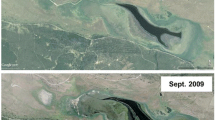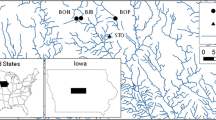Abstract
Although regulatory, agencies in the USA typically require 3–5 yr of post-restoration monitoring of biotic responses to wetland mitigation, many researchers have argued that longer time frames are needed to assess population responses adequately. We conducted an 8-yr study to examine the demographic responses of the wood frog (Rana sylvatica) and spotted salamander (Ambystoma maculatum) to wetland creation at a mitigation bank in western North Carolina. Our primary goals were to compare juvenile output in ten reference and ten constructed ponds and to assess the overall change in breeding population size in response to site restoration. We used annual censuses of egg masses to assess changes in breeding population size and used estimates of larval population size at hatching and the initiation of metamorphosis to assess embryonic and larval survival. Adults of both species bred in most constructed ponds within a few months after filling in 1996. Estimated juvenile production from 1996 to 2002 did not differ significantly between pond types for either species. The percentage of both constructed and reference ponds that produced juveniles decreased markedly from 1996 to 1998 and remained low through 2002. The decrease in juvenile output was mostly associated with reduced larval survival rather than increased embryonic mortality across years. Drought and outbreaks of a pathogen (Ranavirus) were the primary causes of low juvenile production from 1998 to 2002. The overall breeding population of R. sylvatica increased markedly in 1999–2000 following a large recruitment of juveniles from constructed ponds in 1996–1997. With the onset of drought and ranaviral infections, the population declined to levels in 2002 that were at or below 1995 pre-restoration numbers. Despite site perturbations, the breeding population of A. maculatum remained relatively stable from 1995 to 2002, a phenomenon that may reflect selection for delayed reproduction and iteroparity in this species. Although we have monitored R. sylvatica and A. maculatum for seven breeding seasons after the creation of seasonal wetlands, we are still uncertain that site restoration will achieve the goal of increasing breeding populations above pre-restoration levels. Because amphibians have significant population lags and are sensitive to site perturbations, monitoring that exceeds five years may be required to assess demographic responses to site restoration adequately.
Similar content being viewed by others
Literature cited
Babbitt, K. J. and G. W. Tanner. 2000. Use of temporary wetlands by anurans in a hydrologically modified landscape. Wetlands 20: 313–322.
Bervin, K. A. 1982. The genetic basis of altitudinal variation in the wood frog Rana sylvatica: I. An experimental analysis of life history traits. Evolution 36:962–983.
Berven, K. A. 1995. Population regulation in the wood frog, Rana sylvatica, from three, diverse geographic localities. Australian Journal of Ecology 20:385–392.
Brown, S. C., and P. L. M. Veneman. 2001. Effectiveness of compensatory wetland mitigation in Massachusetts, USA. Wetlands 21:508–518.
Confer, S. R. and W. A. Niering. 1992. Comparison of created and natural freshwater emergent wetlands in Connecticut (USA). Wetlands Ecology and Management 2:143–156.
Crouch, W. B. and P. W. C. Paton. 2000. Using egg mass counts to monitor wood frog populations. Wildlife Society Bulletin 28: 895–901.
D’Avanzo, C. 1990. Long-term evaluation of wetland creation projects. p. 487–496. In J. A. Kusler and M. E. Kentula (eds.). Wetland Creation and Restoration: the Status of the Science. Island Press, Washington, DC, USA.
Daszak, P., L. Berger, A. A. Cunningham, A. D. Hyatt, D. E. Green and R. Speare. 1999. Emerging infectious diseases and amphibian population declines Emerging Infectious Diseases 5:1–14.
Gibbs, J. P. 1993. Importance of small wetlands for the persistence of local populations of wetland-associated animals. Wetlands 13: 25–31.
Gibbs, J. P., S. Droege and P. Eagle. 1998. Monitoring populations of plants and animals. BioScience 48:935–940.
Gill, D. E. 1978. The metapopulation ecology of the red-spotted newt, Notophthalmus viridescens (Rafinesque). Ecological Monographs 48:145–166.
Green, D. E., K. A. Converse and A. K. Schrader. 2002. Epizootiology of Sixty-Four Amphibian Morbidity and Mortality Events in the USA, 1996–2001. Annals of the New York Academy of Sciences 969:323–339.
Hecnar, S. J. and R. T. M’Closkey. 1996. Regional dynamics and the status of amphibians. Ecology 77:2091–2097.
Heyer W. R., R. W. McDiarmid, and D. L. Weigmann. 1975. Tadpoles, predation, and pond habitats in the tropics. Biotropica 7: 100–111.
Kats L. B., J. W. Petranka, and A. Sih. 1988 Antipredator defenses and the persistence of amphibian larvae with fishes. Ecology 69: 1865–1870.
Lehtinen, R. M. and S. M. Galatowitsch. 2001. Colonization of restored wetlands by amphibians in Minnesota. The American Midland Naturalist 145:388–396.
Marsh, L. L., D. R. Porter, and D. A. Salvesen 1996. Mitigation Banking: Theory and Practice. Island Press, Washington, DC, USA.
Mierzwa, K. S. 2000. Wetland mitigation and amphibians: Preliminary observations at a southwestern Illinois bottomland hardwood restoration site. Journal of the Iowa Academy of Science 107:191–194.
Mitsch, W. J. and R. F. Wilson. 1996. Improving the success of wetland creation and restoration with know-how, time, and self-design. Ecological Applications 6:77–83.
Moorhead K. K., I. M. Rossell, J. W. Petranka, and C. R. Rossell, Jr. 2001. Tulula wetlands mitigation bank. Ecological Restoration 19:74–80.
Moorhead, K. K. and I. M. Rossell. 1998. Southern mountain fens. p. 379–403. In M. G. Messina and W. H. Conner (eds.) Southern Forested Wetlands: Ecology and Management. Lewis Publishers, Boca Raton, FL, USA.
Moorhead, K. K. 2001. Seasonal water table dynamics of a southern Appalachian floodplain and associated fen. Journal of the American Water Resources Association 37:105–114.
National Resource Council. 2001. Compensating for Wetland Losses Under the Clean Water Act. National Academy Press, Washington, DC, USA.
Paton, P. W. C. and W. B. Crouch III. 2002. Using the phenology of pond-breeding amphibians to develop conservation strategies. Conservation Biology 16:194–204.
Pauli, B. D., J. A. Perrault, and S. L. Money. 2000. RATL: A database of reptile and amphibian toxicology literature. Canadian Wildlife Service, Headquarters, Hull, Québec, PQ, Canada. Technical Report Series No. 357.
Pechmann, J. H. K., D. E. Scott, J. W. Gibbons, and R. D. Semlitsch. 1989. Influence of wetland hydroperiod on diversity and abundance of metamorphosing juvenile amphibians. Wetlands Ecology and Management 1:3–11.
Pechmann, J. H. K., R. A. Estes, D. E. Scott, and J. W. Gibbons. 2001. Amphibian colonization and use of ponds created for trial mitigation of wetland loss, Wetlands 21:93–111.
Petranka, J. W. 1998. Salamanders of the United States and Canada. Smithsonian Institution Press, Washington, DC, USA.
Petranka, J. W. and C. A. Kennedy. 1999. Pond tadpoles with generalized morphology: is it time to reconsider their functional roles in aquatic communities? Oecologia 120:621–631.
Petranka, J. W. and C. K. Smith. 1995. Protocol manual for longterm monitoring of amphibians in GRSM-BLRI-CUGA-MACA Cooperative agreement No. CA-5140-1-9001 with the National Park Service, Atlanta, GA, USA.
Petranka, J. W., A. W. Rushlow, and M. E. Hopey. 1998. Predation by tadpoles of Rana sylvatica on embryos of Ambystoma maculatum: implications of ecological role reversals by Rana (predator) and Ambystoma (prey). Herpetologica 54:1–13.
Pollet, I. and L. I. Bendell-Young. 2000. Amphibians as indicators of wetland quality in wetlands formed from oil sands effluent. Environmental Toxicology and Chemistry 19:2589–2597.
SAS Institute. 1989. SAS User’s Guide, 4th edition. SAS Institute. Cary, NC, USA.
Schneider, D. W. and T. M. Frost. 1996. Habitat duration and community structure in temporary ponds. Journal of the North American Benthological Society 15:64–86.
Semlitsch, R. D. 2000. Principles for management of aquatic-breeding amphibians. Journal of Wildlife Management 64:615–631.
Semlitsch, R. D., D. E. Scott, J. H. K. Pechmann, and J. W. Gibbons. 1996. Structure and dynamics of an amphibian community: evidence from a 16-year study of a natural pond. p. 217–248. In M. L. Cody and J. Smallwood (eds.) Long-term Studies of Vertebrate Communities. Academic Press, San Diego, CA, USA.
Skelly, D. K. 1995. A behavioral trade-off and its consequences for the distribution of Pseudacris treefrog larvae. Ecology 76:150–164.
Skelly, D. K. 1997. Tadpole communities. American Scientist 85: 36–45.
Skelly, D. K., E. E. Werner, and S. A. Cortwright. 1999. Long-term distributional dynamics of a Michigan amphibian assemblage. Ecology 80:2326–2327.
Smith, D. C. and J. Van Buskirk. 1995. Phenotypic design, plasticity, and ecological performance in two tadpole species. The American Naturalist 145:211–233.
Snodgrass, J. W., A. L. Bryan, Jr., and J. Burger, Jr. 2000a. Development of expectations of larval amphibian assemblage structure in southeastern depression wetlands. Ecological Applications 10: 1219–1229.
Snodgrass, J. W., M. J. Komoroski, A. L. Bryan, Jr., and J. Burger, Jr. 2000b. Relationships among isolated wetland size, hydroperiod, and amphibian species richmess: implications for wetland regulations. Conservation Biology 14:414–419.
Stevens, C. A., A. W. Diamond, and T. S. Gabor. 2002. Anuran call surveys on small wetlands in Prince Edward Island, Canada restored by dredging of sediments. Wetlands 22:90–99.
Thomas, L. 1997. Retrospective power analysis. Conservation Biology 11:276–280.
Turner, L. J. and D. K. Fowler. 1981. Utilization of surface mine ponds in east Tennessee by breeding amphibians. United States Fish and Wildlife Service, Atlanta, GA, USA, FWS/OBS-81/08.
Wellborn, G. A., D. K. Skelly, and E. E. Werner. 1996. Mechanisms creating community structure across a freshwater habitat gradient. Annual Review of Ecology and Systematics 27:337–363.
Whigham, D. F. 1999. Ecological issues related to wetland preservation, restoration, creation and assessment. The Science of the Total Environment 240:31–40.
Woodward, B. D. 1983. Predator-prey interactions and breedingpond use of temporary-pond species in a desert anuran community. Ecology 64:1549–1555.
Zedler, J. B. 1996. Ecological issues in wetland mitigation: an introduction to the forum. Ecological Applications 6:33–37.
Author information
Authors and Affiliations
Corresponding author
Rights and permissions
About this article
Cite this article
Petranka, J.W., Murray, S.S. & Kennedy, C.A. Responses of amphibians to restoration of a southern Appalachian wetland: Perturbations confound post-restoration assessment. Wetlands 23, 278–290 (2003). https://doi.org/10.1672/7-20
Received:
Revised:
Accepted:
Issue Date:
DOI: https://doi.org/10.1672/7-20




